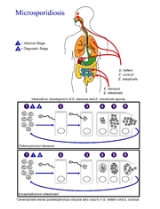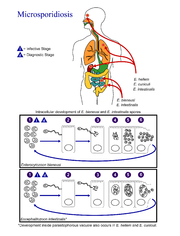
Microsporidiosis
Encyclopedia
Microspridiosis is an opportunistic intestinal infection that causes diarrhea
and wasting in immunocompromised individuals (HIV
, for example). It results from different species of microsporidia
, a group of microbial (unicellular) fungi.
In HIV
infected individuals, microsporidiosis generally occurs when CD4
+ T cell
counts fall below 100.
, their phylogenetic placement has been resolved to be within the Fungi; however, they are highly divergent and rapidly evolving. As unicellular eukaryotes they are still generally considered to be Protists, and some sources classify microsporidiosis as a mycosis
.
s, spread across eight genera:
The primary causes are Enterocytozoon bieneusi
and Encephalitozoon intestinalis
.
 (Coded to image at right).
(Coded to image at right).
Diarrhea
Diarrhea , also spelled diarrhoea, is the condition of having three or more loose or liquid bowel movements per day. It is a common cause of death in developing countries and the second most common cause of infant deaths worldwide. The loss of fluids through diarrhea can cause dehydration and...
and wasting in immunocompromised individuals (HIV
HIV
Human immunodeficiency virus is a lentivirus that causes acquired immunodeficiency syndrome , a condition in humans in which progressive failure of the immune system allows life-threatening opportunistic infections and cancers to thrive...
, for example). It results from different species of microsporidia
Microsporidia
The microsporidia constitute a phylum of spore-forming unicellular parasites. They were once thought to be protists but are now known to be fungi. Loosely 1500 of the probably more than one million species are named now. Microsporidia are restricted to animal hosts, and all major groups of animals...
, a group of microbial (unicellular) fungi.
In HIV
HIV
Human immunodeficiency virus is a lentivirus that causes acquired immunodeficiency syndrome , a condition in humans in which progressive failure of the immune system allows life-threatening opportunistic infections and cancers to thrive...
infected individuals, microsporidiosis generally occurs when CD4
CD4
CD4 is a glycoprotein expressed on the surface of T helper cells, monocytes, macrophages, and dendritic cells. It was discovered in the late 1970s and was originally known as leu-3 and T4 before being named CD4 in 1984...
+ T cell
T cell
T cells or T lymphocytes belong to a group of white blood cells known as lymphocytes, and play a central role in cell-mediated immunity. They can be distinguished from other lymphocytes, such as B cells and natural killer cells , by the presence of a T cell receptor on the cell surface. They are...
counts fall below 100.
Classification
Although it is classified as a protozoal disease in ICD-10ICD-10
The International Statistical Classification of Diseases and Related Health Problems, 10th Revision is a medical classification list for the coding of diseases, signs and symptoms, abnormal findings, complaints, social circumstances, and external causes of injury or diseases, as maintained by the...
, their phylogenetic placement has been resolved to be within the Fungi; however, they are highly divergent and rapidly evolving. As unicellular eukaryotes they are still generally considered to be Protists, and some sources classify microsporidiosis as a mycosis
Mycosis
A mycosis is a fungal infection of animals, including humans. Mycoses are common, and a variety of environmental and physiological conditions can contribute to the development of fungal diseases...
.
Causative agents
At least 14 microsporidian species have been recognized as human pathogenPathogen
A pathogen gignomai "I give birth to") or infectious agent — colloquially, a germ — is a microbe or microorganism such as a virus, bacterium, prion, or fungus that causes disease in its animal or plant host...
s, spread across eight genera:
- Brachiola
- B. algerae, B. connori, B. vesicularum
- Encephalitozoon
- E. cuniculi, E. hellem, E. intestinalis
- Enterocytozoon
- E. bieneusi
- Microsporidium
- M. ceylonensis, M. africanum
- NosemaNosemaFor the genus in Lamiaceae, the mint family, see Nosema .Nosema is a genus of microsporidian parasites, including*Nosema algerae parasitising mosquitoes*Nosema antheraeae parasitising the Chinese oak silkworm Antheraea pernyi...
- N. ocularum
- Pleistophora sp.
- Trachipleistophora
- T. hominis, T. anthropophthera
- Vittaforma
- V. corneae.
The primary causes are Enterocytozoon bieneusi
Enterocytozoon bieneusi
Enterocytozoon bieneusi is a species of the order microsporida which infects the intestinal epithelial cells. It is an obligate intracellular parasite.-Abstract:...
and Encephalitozoon intestinalis
Encephalitozoon intestinalis
Encephalitozoon intestinalis is a parasite. It can cause microsporidiosis.It is notable as having one of the smallest genome among known organisms, containing only 2.25 million base pairs. Its genome was completely sequenced in 2010....
.
Life cycle

- The infective form of microsporidia is the resistant sporeSporeIn biology, a spore is a reproductive structure that is adapted for dispersal and surviving for extended periods of time in unfavorable conditions. Spores form part of the life cycles of many bacteria, plants, algae, fungi and some protozoa. According to scientist Dr...
and it can survive for an exteneded period of time in the environment. - The spore extrudes its polar tubule and infects the host cell.
- The spore injects the infective sporoplasm into the eukaryotic host cell through the polar tubule.
- Inside the cell, the sporoplasm undergoes extensive multiplication either by merogony (binary fission) or schizogony (multiple fission).
- This development can occur either in direct contact with the host cell cytoplasmCytoplasmThe cytoplasm is a small gel-like substance residing between the cell membrane holding all the cell's internal sub-structures , except for the nucleus. All the contents of the cells of prokaryote organisms are contained within the cytoplasm...
(E. bieneusi) or inside a vacuoleVacuoleA vacuole is a membrane-bound organelle which is present in all plant and fungal cells and some protist, animal and bacterial cells. Vacuoles are essentially enclosed compartments which are filled with water containing inorganic and organic molecules including enzymes in solution, though in certain...
called a parasitophorous vacuole (E. intestinalisEncephalitozoon intestinalisEncephalitozoon intestinalis is a parasite. It can cause microsporidiosis.It is notable as having one of the smallest genome among known organisms, containing only 2.25 million base pairs. Its genome was completely sequenced in 2010....
). Either free in the cytoplasm or inside a parasitophorous vacuole, microsporidia develop by sporogony to mature spores. - During sporogony, a thick wall is formed around the spore, which provides resistance to adverse environmental conditions. When the spores increase in number and completely fill the host cell cytoplasm, the cell membrane is disrupted and releases the spores to the surroundings.
- These free mature spores can infect new cells thus continuing the cycle.
External links
- CDC's microsporidiosis info page.

